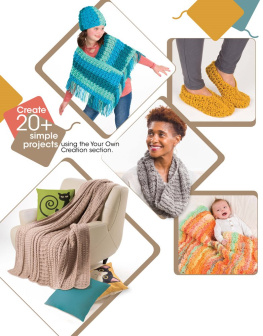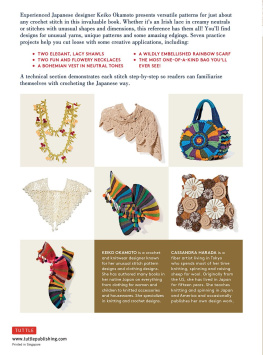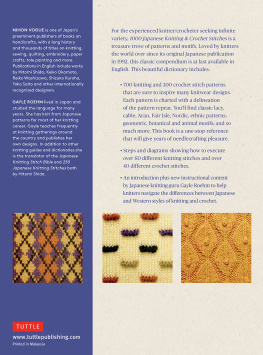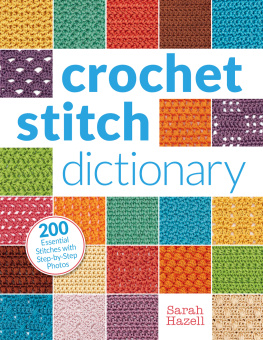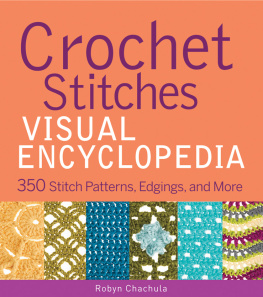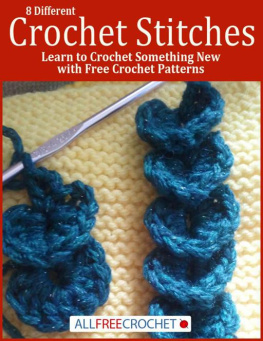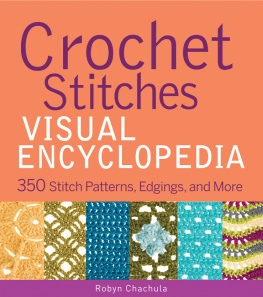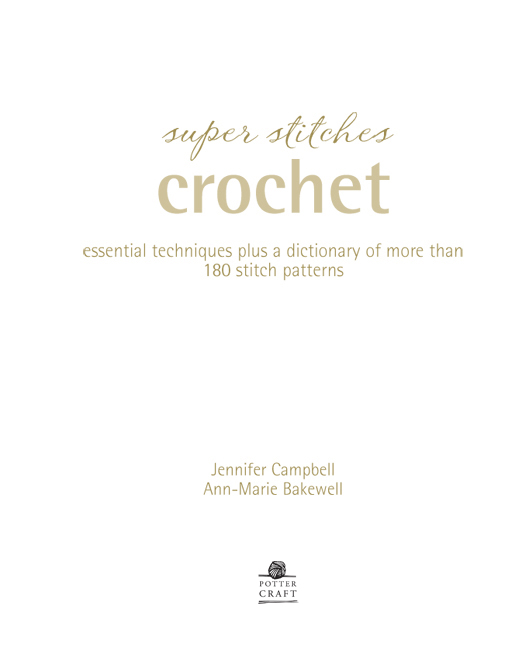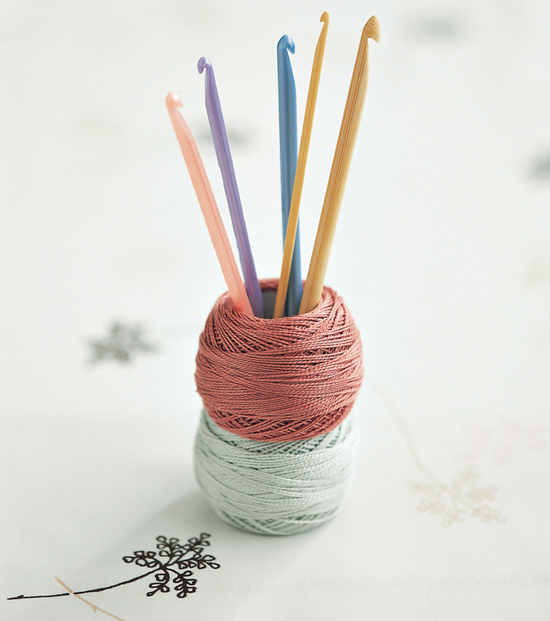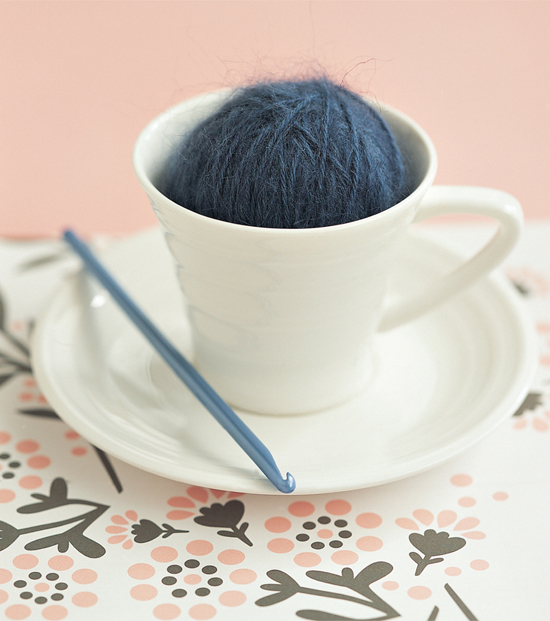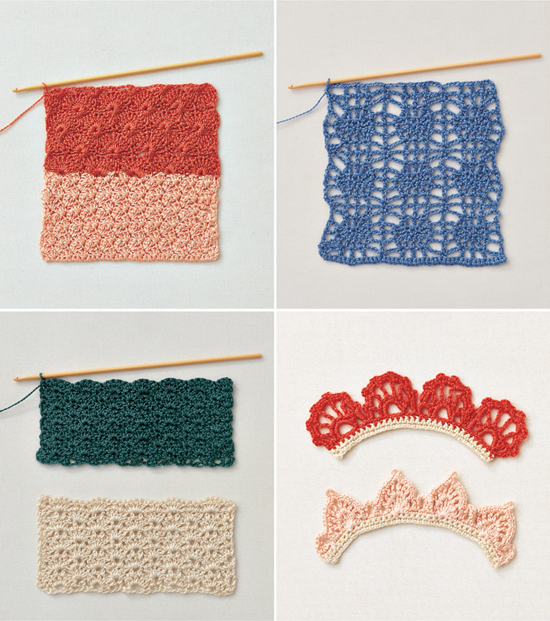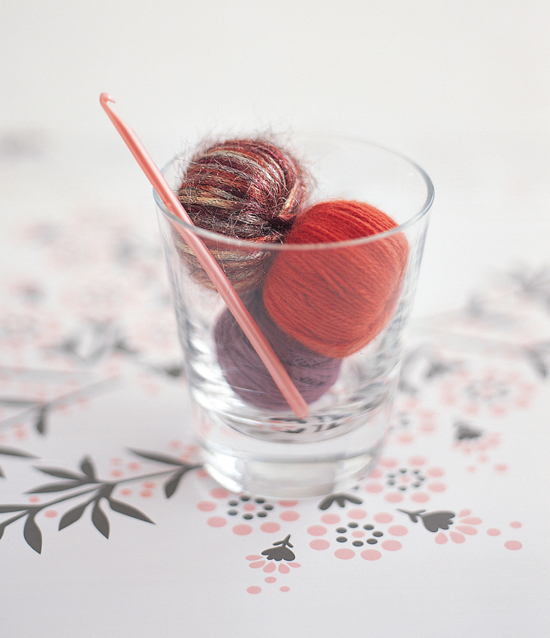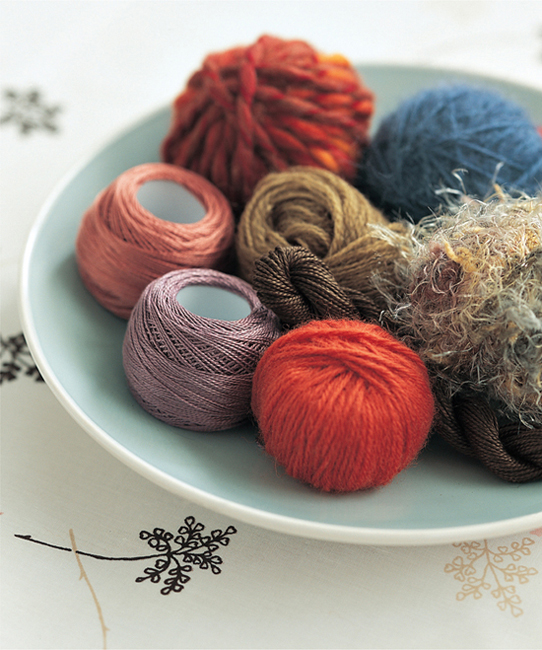Crochet: Jennifer Campbell and Ann-Marie Bakewell
Photography: Ian Hofstetter
Illustrations: Stephen Pollitt
Copyright 2007 by Marabout, Paris
All rights reserved.
Published in the United States by Potter Craft an imprint of the Crown Publishing Group, a division of Random House LLC, a Penguin Random House Company, New York.
www.pottercraft.com
www.crownpublishing.com
POTTER CRAFT and colophon are registered trademarks of Random House LLC
Originally published in the United States by Watson-Guptill, a division of Random House LLC, New York, in 2007.
eBook ISBN: 978-0-553-41913-9
Library of Congress Control Number:
2007935029
First eBook Edition
v3.1
Contents
Swatches (clockwise from top left):
How to use this book
Crochet is formed by working a continuous length of yarn into a fabric of interlocking stitches using a hook. The technique has been known since the end of the eighteenth century and may have developed from tambour work. As was the case with so many handicrafts, it flourished during the nineteenth century, when many of the patterns still used were developed. The word crochet comes from the French word croche , meaning hook.
Terms and symbols
The range of is not large and the techniques are easy to master. These stitches are combined in many ways to create a wide range of patterns. Crochet developed very much as a household craft, however, and the patterns have not been organized in any way. Apart from the basic stitches, most do not have specific, widely recognized names. Even terms such as fan, picot, and cluster will mean different things for each pattern, so always read the whole pattern through before you begin work and make sure you understand what is required in that particular case. In this book the patterns have been grouped according to their appearance so that you can flip through each section to choose a pattern.
This lack of standardization applies also to crochet abbreviations and symbols. A list of common abbreviations, including all those used in this book, is given . Charts were not traditionally used for crochet, but they are becoming more common; and they are included in this book for more complicated patterns.
Swatches
Each pattern in the book has been crocheted, and a full-size photograph is included to give an idea of its appearance. This will, however, vary slightly, depending on the yarn and size of hook used and how tightly you work. These swatches were worked using pearl cotton and a size C/2 (2.5) hook.
Many swatches begin with a foundation row of single crochet to provide a neat edge. This row is not included in the instructions or charts, as it is not part of the pattern.
The swatches show the result for a right-handed crocheter (if you are left-handed, see ).
Starting to crochet
This chapter covers the basic reference material you need to start crocheting: information on yarns and hooks, and lists of the terms, abbreviations, and symbols used in crochet patterns.
Yarns and hooks
In order to crochet you need two things: yarn and a hook. By choosing different types and thicknesses of yarn and different sizes of hooks you can achieve a wide range of effects. For example, a thin yarn and large hook will give a lacy look while a thicker yarn and smaller hook will result in a firmer, stiffer fabric.
Yarns
Crochet can be worked using a wide variety of materials, ranging from the usual cotton and wool yarns to novelty items used for more unusual pieces. As long as a material is flexible enough to be manipulated by the hook and twisted into the stitch shapes, it can be used for crochet.
If your chosen yarn or thread comes in skeins, however, you will need to wind it into a ball before you start crocheting.
Following are just some of the materials that can be used for crochet work.
Crochet cotton is a fine, smooth yarn that has been mercerized (treated with alkali to improve strength and luster). It comes in a wide range of thicknesses, from 60 (very fine) to 5 (the thickest). It has traditionally been used for crochet work, including table runners and doilies, throws, garments, and edgings for embroidery.
Pearl cotton , or perle cotton, is a softer, less tightly twisted thread usually sold for embroidery. It comes in a variety of thicknesses (3, 5, 8, and 12, with 3 the thickest). The swatches in this book were made using pearl cotton.
Knitting yarns , including cotton, wool, silk, and synthetics, are also often used for crochet work. Firmly spun ones are easier to use and give a neater finish. However, softer, more loosely spun yarns can produce beautiful results if you are willing to persevere. Wool is very popular for crochet work, especially for garments and rugs.
Metallic embroidery threads can be used alone or incorporated into other work.
Woven fabric , cut into strips about 1 inch (2.5 cm) wide and folded so the edges are hidden, can be used with a large hook. Fine cotton fabric and single crochet will give the best results. Leather can also be cut into strips for crocheting.
String and raffia can be used for crocheting items such as handbags.
Soft wire can also be used to create sculptural effects and jewelry.
Hooks
Crochet hooks come in a range of materials. The small ones used with fine yarns are generally metal (steel or coated aluminum), but hooks can also be plastic, bamboo, or wood. Which type you use is a matter of personal preference.
Always use hooks that are in good condition. Rusty or tarnished steel hooks may stain the yarn, while nicks in plastic or wooden ones will catch on the yarn and damage it.
There are three sizing systems used for crochet hooks:
the American system ,
the metric system developed in Europe,
the Imperial system developed in the UK.
The tables at right are a guide to the most common sizes (larger and smaller hooks are also available). The equivalencies shown are not exact, and, indeed, different brands can also vary slightly in size.
Experiment to determine the hook to use to get the effect you want. You may also need to use a slightly smaller or larger hook than that specified in a pattern to .
Hook sizes
(plastic, wood and bamboo, and aluminum)
| American | Metric (mm) | Imperial |
| B/1 |


